
The detection of volatile gases can be critical in public health, workplace safety, military and rescue situations. The process requires the use of electronic devices operated by specially trained technicians. Engineers at Tufts University’s School of Engineering have recently developed threads that can detect dangerous gases—and while the technology doesn’t replace the precision of electronic devices, it could offer an equipment-free alternative accessible to a general workforce or to low-resource communities.
The dyed threads, which can be woven into clothing, change color when they detect a variety of gases. The technology works like this: The thread is dipped in the dye and then treated with acetic acid, which makes the surface coarser and swells the fiber, possibly allowing more binding interactions between the dye and thread. The thread is then treated with polydimethylsiloxane (PDMS), which creates a flexible, physical seal around the thread and dye that also repels water and prevents dye from leaching. PDMS is also gas permeable, which enables the chemical components to reach the optical dyes.
The color change that took place during a recent study (see above image) was dependent on and proportional to the concentration of the gas as measured using spectroscopic methods, which measure wavelengths of light. The color change can be detected by the naked eye or with a smartphone camera, which detects changes of color due to chemical components as low as 50 parts per million.
The researchers demonstrated that the fabric also worked under water; for example, fabrics including the smart threads could detect carbon dioxide or other volatile organic compounds during oil and gas exploration. For information, visit www.tufts.edu.
 TEXTILES.ORG
TEXTILES.ORG


